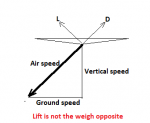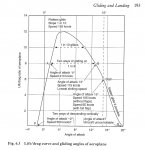XXavier
Member
- Joined
- Nov 13, 2006
- Messages
- 1,481
- Location
- Madrid, Spain
- Aircraft
- ELA R-100 and Magni M24 autogyros
- Total Flight Time
- 913 gyro (June 2023)
I agree with J.R. and Antony.
The definition I use for Lift to drag ratio (L/D) is the lift of an airfoil divided by the drag of the airfoil.
In my opinion it does not go to zero because a gyroplane is not moving forward (a vertical descent) because part of the airfoil is still providing lift and the airfoil still has drag as it provides lift.
The definition I use for Glide Ratio is the distance the aircraft flies forward divided by the sink.
There is much more involved in Glide Ratio than the L/D ratio of the airfoil.
In my opinion Glide Ratio is what goes to zero in a vertical descent.
Glide ratio and L/D are numerically identical for any aircraft.
Think of that aircraft falling vertically. There is an aerodynamic force acting on it. Now, the conventional definition of lift is the component of that force perpendicular to the relative wind. It's quite obvious that, in the case of any object falling in vertical direction, that componente is zero, because if it weren't zero, the fall wouldn't be vertical...
Well, we now now that L is zero. Hence, L/D must be zero... And the glide ratio, being numerically identical to L/D, is zero too...
Yes, there may be parts of the falling object, like blades or fins, where –locally– a certain lift does exist, but globally considered, the whole lift of that falling object is zero.


